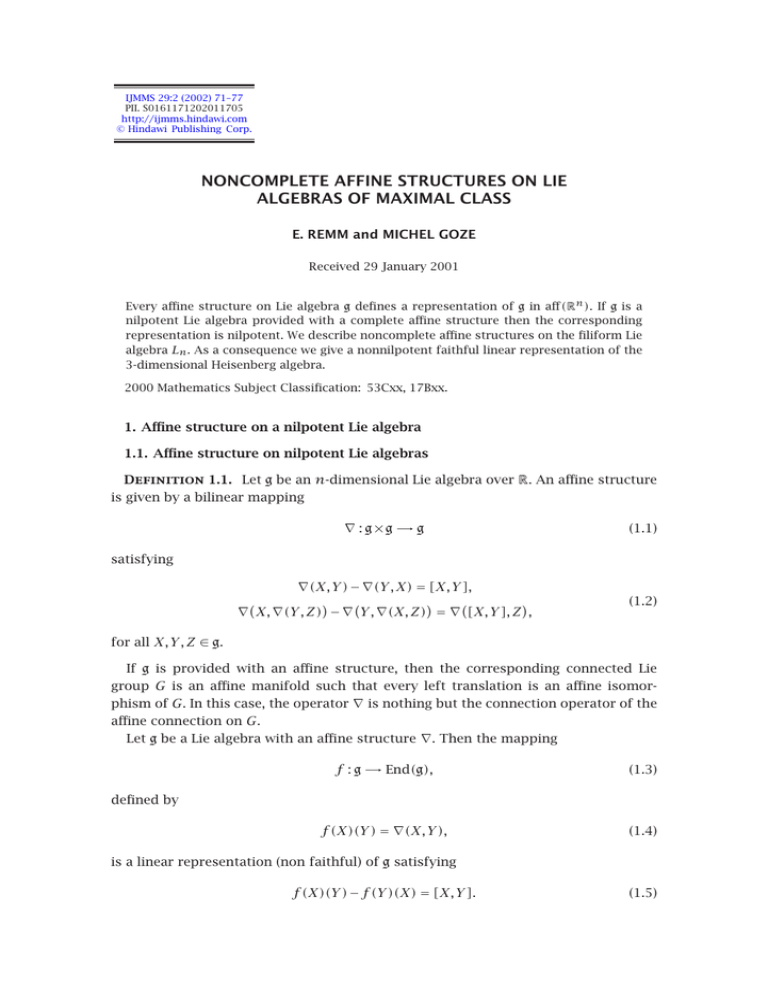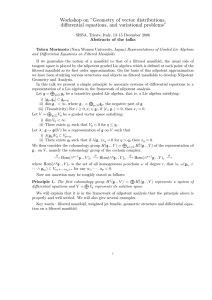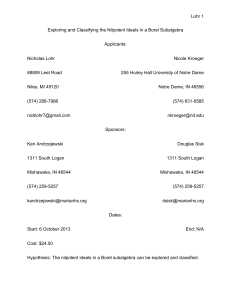NONCOMPLETE AFFINE STRUCTURES ON LIE ALGEBRAS OF MAXIMAL CLASS
advertisement

IJMMS 29:2 (2002) 71–77
PII. S0161171202011705
http://ijmms.hindawi.com
© Hindawi Publishing Corp.
NONCOMPLETE AFFINE STRUCTURES ON LIE
ALGEBRAS OF MAXIMAL CLASS
E. REMM and MICHEL GOZE
Received 29 January 2001
Every affine structure on Lie algebra g defines a representation of g in aff(Rn ). If g is a
nilpotent Lie algebra provided with a complete affine structure then the corresponding
representation is nilpotent. We describe noncomplete affine structures on the filiform Lie
algebra Ln . As a consequence we give a nonnilpotent faithful linear representation of the
3-dimensional Heisenberg algebra.
2000 Mathematics Subject Classification: 53Cxx, 17Bxx.
1. Affine structure on a nilpotent Lie algebra
1.1. Affine structure on nilpotent Lie algebras
Definition 1.1. Let g be an n-dimensional Lie algebra over R. An affine structure
is given by a bilinear mapping
∇ : g × g → g
(1.1)
∇(X, Y ) − ∇(Y , X) = [X, Y ],
∇ X, ∇(Y , Z) − ∇ Y , ∇(X, Z) = ∇ [X, Y ], Z ,
(1.2)
satisfying
for all X, Y , Z ∈ g.
If g is provided with an affine structure, then the corresponding connected Lie
group G is an affine manifold such that every left translation is an affine isomorphism of G. In this case, the operator ∇ is nothing but the connection operator of the
affine connection on G.
Let g be a Lie algebra with an affine structure ∇. Then the mapping
f : g → End(g),
(1.3)
f (X)(Y ) = ∇(X, Y ),
(1.4)
defined by
is a linear representation (non faithful) of g satisfying
f (X)(Y ) − f (Y )(X) = [X, Y ].
(1.5)
72
E. REMM AND M. GOZE
Remark 1.2. The adjoint representation f of g satisfies
f(X)(Y ) − f(Y )(X) = 2[X, Y ]
(1.6)
and cannot correspond to an affine structure.
1.2. Classical examples of affine structures. (i) Let g be the n-dimensional abelian
Lie algebra. Then the representation
f : g → End(g),
X → f (X) = 0
(1.7)
defines an affine structure.
(ii) Let g be a 2p-dimensional Lie algebra endowed with a symplectic form
θ ∈ Λ2 g ∗
such that dθ = 0
(1.8)
with
dθ(X, Y , Z) = θ X, [Y , Z] + θ Y , [Z, X] + θ Z, [X, Y ] .
(1.9)
For every X ∈ g we can define a unique endomorphism ∇X by
θ ad X(Y ), Z = −θ Y , ∇X (Z) .
(1.10)
Then ∇(X, Y ) = ∇X (Y ) is an affine structure on g.
(iii) Following the work of Benoist [1] and Burde [2, 3, 4], we know that there exists
a nilpotent Lie algebra without affine structures.
1.3. Faithful representations associated to an affine structure. Let ∇ be an affine
structure on an n-dimensional Lie algebra g. We consider the (n + 1)-dimensional
linear representation given by
ρ : g → End g
R
(1.11)
given by
ρ(X) : (Y , t) → ∇(X, Y ) + tX, 0 .
(1.12)
It is easy to verify that ρ is a faithful representation of dimension n + 1.
We can note that this representation gives also an affine representation of g
A(X) X
ψ : g → aff Rn , X →
,
(1.13)
0
0
where A(X) is the matrix of the endomorphisms ∇X : Y → ∇(X, Y ) in a given basis.
Definition 1.3. We say that the representation ρ is nilpotent if the endomorphisms ρ(X) are nilpotent for every X in g.
Proposition 1.4. Suppose that g is a complex non-abelian indecomposable nilpotent Lie algebra and let ρ be a faithful representation of g. Then there exists a faithful
nilpotent representation of the same dimension.
NONCOMPLETE AFFINE STRUCTURES ON LIE ALGEBRAS . . .
73
Proof. Consider the g-module M associated to ρ. Then, as g is nilpotent, M can
be decomposed as
M=
k
Mλi ,
(1.14)
i=1
where Mλi is a g-submodule, and the λi are linear forms on g. For all X ∈ g, the restriction of ρ(X) to Mi is in the following form:
λi (X)
∗
···
∗
..
..
..
0
.
.
.
.
(1.15)
.
..
..
.
.
.
∗
.
0
···
0
λi (X)
Let Kλi be the one-dimensional g-module defined by
µ : X ∈ g → µ(X) ∈ End K
(1.16)
µ(X)(a) = ρ(X)(a) = λi (X)a.
(1.17)
with
The tensor product Mλi ⊗ K−λi is the g-module associated to
(1.18)
X · (Y ⊗ a) = ρ(X)(Y ) ⊗ a − Y ⊗ λi (X)a.
= (Mλ ⊗ K−λ ) is a nilpotent g-module. We prove that M
is faithful. Recall
Then M
i
i
that a representation ρ of g is faithful if and only if ρ(Z) ≠ 0 for every Z ≠ 0 ∈ Z(g).
Consider X ≠ 0 ∈ Z(g). If ρ(X)
= 0, then ρ(X) is a diagonal endomorphism. By hypothesis g ≠ Z(g) and there is i ≥ 1 such that X ∈ Ꮿi (g), we have
X = aj Yj , Zj
(1.19)
j
with Yj ∈ Ꮿ (g) and Zj ∈ g. The endomorphisms ρ(Yj )ρ(Zj )−ρ(Zj )ρ(Yj ) are nilpotent and the eigenvalues of ρ(X) are 0. Thus ρ(X) = 0 and ρ is not faithful. Then
ρ(X)
≠ 0 and ρ is a faithful representation.
i−1
2. Affine structures on Lie algebra of maximal class
2.1. Definition
Definition 2.1. An n-dimensional nilpotent Lie algebra g is called of maximal
class if the smallest k such that Ꮿk g = {0} is equal to n − 1.
In this case the descending sequence is
g ⊃ Ꮿ1 g ⊃ · · · ⊃ Ꮿn−2 g ⊃ {0} = Ꮿn−1 g
(2.1)
and we have
dimᏯ1 g = n − 2,
dimᏯi g = n − i − 1,
for i = 1, . . . , n − 1.
(2.2)
74
E. REMM AND M. GOZE
Example 2.2. The n-dimensional nilpotent Lie algebra Ln defined by
X1 , Xi = Xi+1
for i ∈ {2, . . . , n − 1}
(2.3)
is of maximal class.
We can note that any Lie algebra of maximal class is a linear deformation of Ln [5].
2.2. On non-nilpotent affine structure. Let g be an n-dimensional Lie algebra of
maximal class provided with an affine structure ∇. Let ρ be the (n + 1)-dimensional
faithful representation associated to ∇ and we note that M = g C is the corresponding complex g-module. As g is of maximal class, its decomposition has one of the
following forms
M = M0 ,
M is irreducible,
(2.4)
or
M = M0
Mλ ,
λ ≠ 0.
(2.5)
For a general faithful representation, we call characteristic the ordered sequence
of the dimensions of the irreducible submodules. In the case of maximal class we
have c(ρ) = (n + 1) or (n, 1) or (n − 1, 1, 1) or (n − 1, 2). In fact, the maximal class
of g implies that there exists an irreducible submodule of dimension greater than or
equal to n−1. More generally, if the characteristic sequence of a nilpotent Lie algebra
is equal to (c1 , . . . , cp , 1) (see [5]) then for every faithful representation ρ we have
c(ρ) = (d1 , . . . , dq ) with d1 ≥ c1 .
Theorem 2.3. Let g be the Lie algebra of the maximal class Ln . Then there are
faithful g-modules which are not nilpotent.
Proof. Consider the following representation given by the matrices ρ(Xi ) where
{X1 , . . . , Xn } is a basis of g
a
a
0
..
.
.
.
ρ X1 =
.
.
..
0
α
0
a
0
a
0
0
..
.
0
1
2
..
.
···
..
.
..
.
..
.
0
···
0
..
.
0
..
.
..
..
.
..
.
.
i−3
i−2
..
.
..
.
..
.
β
0
···
···
0
0
0
0
0
0
..
.
n−3
n−2
0
..
.
0
0
1
0
0
0
0 ,
0
0
0
0
NONCOMPLETE AFFINE STRUCTURES ON LIE ALGEBRAS . . .
a
a
−1
0
..
ρ X2 =
.
..
.
0
β
0
a
0
a
0
1
0
0
1
2
..
.
···
..
.
..
.
..
···
···
0
..
.
0
..
.
..
.
0
..
.
..
.
.
1
i−2
..
.
..
.
..
.
..
.
..
.
α
0
···
···
···
1
n−2
0
0
0
0
0
0
0
0
0
1
0
0
0
,
0
0
0
0
75
(2.6)
and for j ≥ 3 the endomorphisms ρ(Xj ) satisfy
1
ej+1 ,
ρ Xj e 1 = −
j −1
ρ Xj e 2 =
1
ej+1 ,
j −1
ρ Xj e 3 =
1
ej+2 ,
j(j − 1)
..
.
(2.7)
(j − 2)!(i − j − 1)!
ei , i = j − 2, . . . , n,
ρ Xj ei−j+1 =
(i − 2)!
ρ Xj ei−j+1 = 0, i = n + 1, . . . , n + j − 1,
ρ Xj en+1 = ej ,
where {e1 , . . . , en , en+1 } is the basis given by ei = (Xi , 0) and en+1 = (0, 1). We easily
verify that these matrices describe a nonnilpotent faithful representation.
2.3. Noncomplete affine structure on Ln . The previous representation is associated to an affine structure on the Lie algebra Ln given by
∇ Xi , Y = ρ Xi (Y , 0),
(2.8)
where Ln is identified to the n-dimensional first factor of the (n + 1)-dimensional
faithful module. This affine structure is complete if and only if the endomorphisms
RX ∈ End(g) defined by
RX (Y ) = ∇(Y , X)
(2.9)
76
E. REMM AND M. GOZE
are nilpotent for all X ∈ g (see [6]). But the matrix of RX1 has the form
a
a
0
0
.
.
.
0
α
0
a
0
···
0
..
.
..
.
···
0
..
.
..
.
···
0
···
0
a
−1
0
..
.
−
1
2
..
.
0
0
..
.
..
.
β
..
.
···
0
0
0
···
−
1
j −1
..
.
0
..
.
0
0
..
.
..
.
0
1
−
n−2
0
0
1
.
0
0
0
0
(2.10)
Its trace is 2a and for a ≠ 0 it is not nilpotent. We have proved the following proposition.
Proposition 2.4. There exist affine structures on the Lie algebra of maximal class
Ln which are noncomplete.
Remark 2.5. The most simple example is on dim 3 and concerns the Heisenberg
algebra. We find a nonnilpotent faithful representation associated to the noncomplete
affine structure given by
a a 0
a
a
0
0 0 0
a
0
∇X1 =
∇X2 =
∇X3 =
a a 0 ,
a
0 0 0 , (2.11)
,
α β 0
β−1 α+1 0
0 0 0
where X1 , X2 , and X3 are a basis of H3 satisfying [X1 , X2 ] = X3 and ∇Xi the endomorphisms of g given by
∇Xi Xj = ∇ Xi , Xj .
The affine representation is written as
a x 1 + x2
a x1 + x 2
a x1 + x2
a x1 + x 2
αx + (β − 1)x
βx1 + (α + 1)x2
2
1
0
0
(2.12)
0
0
0
0
x1
x2
.
x3
0
(2.13)
References
[1]
[2]
[3]
[4]
Y. Benoist, Une nilvariété non affine [A non-affine nilvariety], J. Differential Geom. 41
(1995), no. 1, 21–52 (French).
D. Burde, Affine structures on nilmanifolds, Internat. J. Math. 7 (1996), no. 5, 599–616.
, Left-invariant affine structures on reductive Lie groups, J. Algebra 181 (1996), no. 3,
884–902.
, Simple left-symmetric algebras with solvable Lie algebra, Manuscripta Math. 95
(1998), no. 3, 397–411.
NONCOMPLETE AFFINE STRUCTURES ON LIE ALGEBRAS . . .
[5]
[6]
77
M. Goze and Y. Khakimdjanov, Nilpotent Lie Algebras, Mathematics and Its Applications,
vol. 361, Kluwer Academic Publishers Group, Dordrecht, 1996.
J. Helmstetter, Radical d’une algèbre symétrique à gauche, Ann. Inst. Fourier (Grenoble)
29 (1979), no. 4, 17–35 (French).
E. Remm: Faculté des Sciences et Techniques, 4, Rue des Frères Lumière, F. 68093
Mulhouse Cedex, France
E-mail address: e.remm@univ-mulhouse.fr
Michel Goze: Faculté des Sciences et Techniques, 4, Rue des Frères Lumière, F. 68093
Mulhouse Cedex, France
E-mail address: m.goze@univ-mulhouse.fr



